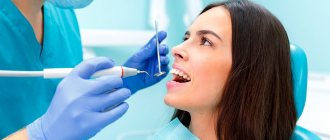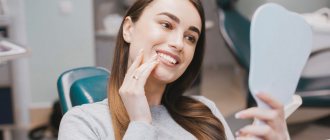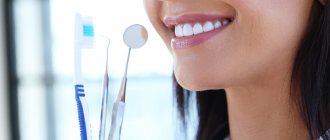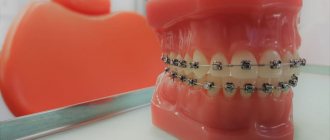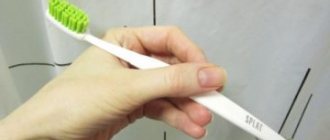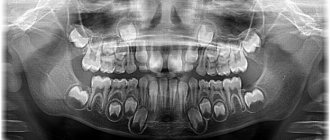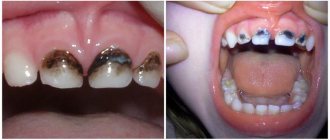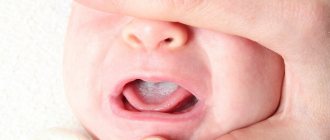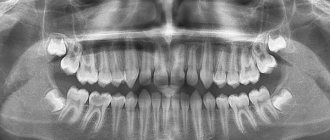Anna Andreevna Bespalova, a dentist-therapist at the Denta-El clinic, talks about what procedures are necessary to prevent and protect against oral diseases, as well as how to effectively combat diseases such as caries, stomatitis, etc.
It is common knowledge that poor oral hygiene is the root cause of all problems. However, not everyone understands why hygiene is so important. Without constant care, accumulations of plaque (at first soft) form in the mouth, becoming an ideal breeding ground for bacteria.
They digest plaque and release acids that negatively affect teeth. The layers of calcium are washed away and the enamel dissolves, becoming brittle. As a result, so-called demineralization of the enamel is observed, which ultimately leads to the formation of caries.
In childhood, this often manifests itself as white (sometimes yellow) spots on the teeth on the front side. The next stage after this is caries.
Tartar
Tartar is a soft plaque that has been in the mouth for so long that it has hardened to such an extent that it seems to “ stick ” to the tooth. At the same time, in addition to difficulties with hygiene, the stone can cause inflammation of the marginal gum - swelling and bleeding, causing constant discomfort. As a result, children try to avoid inflamed areas when brushing their teeth.
The result of this process is gingivitis and stomatitis , and in advanced cases, gum atrophy occurs along with exposure of the dental necks. The sensitivity of teeth to temperature and other influences increases significantly .
Choosing a toothpaste for a child
First you need to determine what characteristics toothpaste for children should have.
An effective children's toothpaste should prevent dental caries, restore enamel in its initial stages of destruction, and also inhibit the metabolic processes of bacteria, thereby weakening their ability to form acids that destroy tooth enamel, and slow down the formation and spread of plaque. Toothpaste for children must have a pleasant taste.
How to remove plaque
Removing soft and hard plaque from teeth seems to be an elementary procedure, but, nevertheless, it requires the specialist, in addition to attention, to have some experience in such operations . The soft coating is removed with special rubber bands (or a brush). As a rule, children do not object to this - they do not experience discomfort or pain as a result of the procedure . But the importance of such a procedure is difficult to overestimate - despite its apparent simplicity, it can become an important preparation for subsequent treatment, accustoming the child to manipulations in the oral cavity.
In the case of tartar, special devices - ultrasonic or manual.
Professional teeth cleaning for children of all ages
The hygiene of baby teeth is just as important as the hygiene of permanent teeth. The well-being and mood of the baby, and in the future, the formation of a correct permanent bite, with which the child will have to live his whole life, directly depends on their health. No matter how hard she tries, a mother cannot brush her child’s baby teeth thoroughly enough, so professional cleaning at this age is especially important. Using a soft brush, the doctor will carefully clean each tooth, and at the same time make sure that there is no caries or other diseases.
It is important to consider that a child develops three different bites at different times:
- milk (up to 4-5 years);
- replaceable (up to 14-15 years);
- permanent (15 and older).
From about 5 to 14 years of age, a child has both primary and permanent teeth. This combination is called a mixed bite (or mixed). The main feature of a mixed bite is that the teeth have different heights, and this complicates self-cleaning.
This is also a very important period, since it is at this age that a permanent bite is formed, with which the child will have to live his entire adult life. It is important to avoid inflammatory processes, caries and other oral diseases that can affect the growth and formation of permanent teeth.
It is important to know! Many parents are sure that their children do not develop tartar. But in the oral cavity of a child, the same processes occur as in adults, and therefore the stone is formed in the same way. It's just not as noticeable in children because they don't smoke, drink coffee or drink tea in the same quantities as adults.
By the age of 14-15, children have only permanent teeth. Usually a child at this age already knows how to clean them on his own, without missing hard-to-reach places. But it’s still worth signing him up for professional cleaning, since the doctor will be able to tell him what mistakes he’s making.
Frequency and periodicity of professional hygiene
Of course, the frequency of professional cleaning is different for each child , and depends mainly on the quality of dental care - some children brush their teeth so well that they can only be taken to a specialist annually, while others ...
When undergoing orthodontic treatment, crowded teeth or poor hygiene, preventive maintenance and professional cleaning should be performed as often as possible .
Do not underestimate the importance of professional cleaning - after all, during it, the doctor will not only teach the child how to properly care for his teeth, but will also select individual products or medications - this is especially important for various diseases or defects of the oral cavity. For example, if there is crowding, a regular toothbrush is not very effective; in this case, the child needs a special brush.
Competent selection of hygiene products for children
Oral hygiene can be a pleasant experience if you teach your child to brush their teeth correctly from an early age. Doctors advise:
- Buy your baby's first brush with very soft bristles.
- Change your toothbrush as recommended by your pediatric dentist or dental hygienist.
- Parents and children should choose the first brushes with a long handle for cleaning their teeth.
- Buy toothpaste according to the baby's age.
- Choose safe toothpastes.
Features of professional oral hygiene
Oral hygiene in children three to five years old
- removal of plaque and plaque using rotary brushes (using low-abrasive pastes);
- floss polishing
- remineralizing therapy (local, using gels and jellies).
Oral hygiene in children six to ten years old
- determination of quality of care ( plaque markers
- regular teeth cleaning under the supervision of a specialist;
- hygiene index – the quality of the child’s teeth brushing, his mistakes;
- training in proper cleaning;
- repeated cleaning under the supervision of a specialist, taking into account her recommendations;
- removal of plaque and plaque using rotary brushes (using low-abrasive pastes);
- polishing with rubber heads and paste; strips (strips);
- remineralizing therapy (office or at home);
- local fluoridation using gels, jellies or varnishes.
Oral hygiene in adolescents aged eleven to sixteen
- removal of plaque and plaque using rotary brushes (using low-abrasive pastes and air-abrasive devices). For mineralized deposits - cleaning with ultrasonic tips ;
- periodontal soft tissue indices. If symptoms of inflammation are detected, anti-inflammatory treatment is carried out;
- remineralizing therapy (at the dentist or at home).
Peculiarities
Visiting the dentist from an early age helps avoid fear of dental treatment in the future.
Hygiene for children has such features.
- The procedure is carried out quickly (the kids do not get tired).
- Special brushes (with high speed) and pastes are used.
- Remove soft and hard plaque, pigmented plaque, polish the enamel with special pastes;
- After the procedure, the enamel is coated with a special agent (varnish or solution) to saturate the tooth with calcium, fluorine and phosphorus ions.
Basic personal hygiene mistakes
- the procedure is performed too quickly ;
- cleaning occurs before eating ;
- no intermediate hygiene during the day (after meals);
- incorrect cleaning method. It is necessary to clean your teeth from all sides;
- insufficient care for hard-to-reach places - oral care methods
- poor selection of hygiene products. They also need to be constantly replaced with new ones;
- abuse of bleaching pastes based on peroxide compounds (usually with increased abrasive properties). This leads to the spread of pathogens .
All these mistakes often result from a lack of awareness among children and parents themselves about proper oral hygiene. To avoid this, regular consultations with an orthodontist are necessary.
Visiting the dentist:
- Twice a year
Examination of children for early diagnosis of dental caries and its complications. Detection of dental anomalies and early orthodontic treatment. Monitoring the condition of the gums and periodontal tissues. Recommendations for brushing teeth. Selection of oral hygiene products. Removing dental plaque and plaque (if necessary). Sealing of dental fissures
Brushing your teeth: In the morning after breakfast and in the evening before bed. Teeth brushing time – 3 minutes.
Basic oral hygiene products:
- Manual toothbrush/ electric toothbrush
- Toothpaste (as recommended by a dentist)
A manual toothbrush should have: medium-hard bristles; rounded and polished bristle tips; a rounded head shape corresponding to the size of the teeth; small head, which ensures maneuverability in the oral cavity; volumetric handle for better grip of the brush in your hand.
For children over six years old, we can recommend an electric children's toothbrush: with soft two-level bristles; with indication of bristle wear; with a round head.
Additional oral hygiene products are used on the recommendation of a dentist and under the supervision of parents from 7-9 years:
- Dental floss
- Rinse aid
- Chewing gum without sugar with xylitol
- Foams
- Tongue scraper
- Dental brushes
Using dental floss (FLOSSA)
Starting from the age of 7, it is necessary to introduce the use of dental floss into personal hygiene. This is especially indicated for children with a high risk of caries, with crowded teeth, and those undergoing orthodontic treatment using fixed orthodontic appliances.
It is recommended to use dental floss before brushing your teeth with toothpaste, and if you use a mouthwash, then after toothpaste, before the rinsing procedure. Dental floss, or floss, was developed specifically for cleaning the contact surfaces of teeth that are difficult to reach with a brush.
Mouth rinse is recommended as an additional hygiene product, because... It cleans the interdental spaces well and has a deodorizing effect. The rinse aid must contain fluoride and not contain alcohol. Rinse your mouth for 1 minute, do not swallow.
The use of dental rinses allows you to destroy a significant part of the bacteria remaining after brushing. By improving the condition of the gums, the risk of periodontitis and other dental diseases is reduced. Teeth rinses help maintain their whiteness, strengthen enamel, fight the formation of tartar and prevent the formation of caries.
Foam is used to clean teeth when it is not possible to use a regular toothbrush. The action of foams is expressed in cleaning and leveling the acid-base balance in the oral cavity, which prevents the growth of dental plaque and the development of pathogenic microorganisms in it.
Xylitol (xylitol) has pronounced anti-caries properties: it has a specific antimicrobial effect against the most cariogenic microorganisms, accelerates salivation, improves self-cleaning of the oral cavity and increases the ability of saliva to strengthen tooth enamel. The use of chewing gum containing xylitol is recommended after meals for 10-15 minutes.
ATTENTION! However, it must be remembered that excessive intake of xylitol into the body can lead to unwanted side effects, as it promotes diarrhea. The daily dose of xylitol for an adult is from 30 to 50 grams.
Professional oral hygiene (teeth brushing) is a system of treatment and preventive measures performed in a dental clinic, aimed at preventing the occurrence and progression of oral diseases. In this case, the doctor or hygienist removes plaque and tartar and polishes the surfaces of the teeth.
Professional oral hygiene should be carried out at least once a year.
Nutrition:
Products that are healthy for teeth should contain a small amount of sugar and sufficient amounts of vitamins and minerals. It is good to eat solid foods.
Avoid eating sugar-containing foods (sweets, cookies, etc.) between main meals.
Avoid drinking sugary carbonated drinks.
| Healthy foods for teeth Raw vegetables and fruits Nuts, dried fruits Milk, cheese, meat Fish, tea | Harmful foods for teeth Caramel, lollipops, chocolate Sweet carbonated drinks Sugar-containing chewing gum |
At the age of 6-15 years, the temporary teeth are replaced by permanent teeth.
Timely and consistent teething indicates the normal development of the child’s body. Violation of the timing and sequence of eruption can occur with endocrine and metabolic disorders or general diseases of the child.
Dental caries
Dental caries is a disease of hard dental tissues that occurs due to irregular oral hygiene and excessive consumption of sweets.
Damage to teeth by caries is always accompanied by a violation of their function; when teeth are destroyed, difficulties arise when eating, pain, disturbances in appearance, especially when caries affects the anterior group of teeth. Caries of temporary and permanent teeth in children occurs with the same unpleasant sensations as in adults.
From the age of 6, temporary teeth begin to fall out and permanent teeth erupt.
The first permanent molars appear in the oral cavity as the very first of the permanent teeth behind the temporary molars at the back, so parents do not pay enough attention to these teeth, not noticing them.
Maturation of enamel (strengthening) continues after teething in the oral cavity, so it is extremely important to create adequate conditions for this process: for this it is necessary to carry out professional oral hygiene with the application of special mineral gels, and thoroughly brush your teeth at home.
Attention!!! On the chewing surfaces of the first permanent molars, deep pits (fissures) are often identified, which are primarily affected by caries. To protect against caries, immediately after the eruption of these teeth, it is necessary to carry out a sealing technique, which includes filling the fissures with a special material.
Therefore, it is important to visit the dentist on time to identify caries, its treatment and prevention, both in temporary and even more so in permanent teeth.
IMPORTANT!
If dark gray spots appear on the teeth, if the teeth react to cold, hot, sweet, sour, and even more so, if carious cavities are visible on the teeth, then the child clearly has caries. You need to contact your dentist immediately! If there is crowding of teeth, a permanent tooth did not erupt smoothly or at the wrong time, if bleeding occurs when brushing your teeth, you should immediately contact your dentist!
Remember that you should contact the dentist when the child is healthy and does not experience toothache!
Gum care in the first months of life
The first six months of life is the period when microbes populate the child’s mouth , which means that there is an increased likelihood of diseases - caries, stomatitis, infantile thrush, etc. Parents and other relatives often cause such diseases by transmitting germs to the baby through kisses, pacifiers, dishes and neglect to wash objects with boiled water. To minimize the risk, your child should wipe their gums with special wipes or finger tips every time after eating.
Cleaning baby teeth
Children should brush their baby teeth with a special brush for babies . At the beginning, the cleaning time should be 15-20 seconds , then the duration should be gradually increased . The most difficult thing at this moment, of course, is to arouse the child’s interest in this boring activity, from his point of view.
There are two methods as old as the world that have never lost their effectiveness:
- Turn hygiene training into a game - what little kid wouldn't love a flying spaceship brush or a superhero protecting his teeth? If the child is interested, he will voluntarily let his teeth be brushed and wait until the procedure is over. Perhaps even patiently.
- teach a child to do like mom or dad - children love to repeat after their parents. This feature can easily be used in the process of teaching children how to brush their teeth. Doing this with your child every day, you will find that your baby himself is demanding that the ritual be continued. The most important thing is that the pasta is to your taste .
It happens that toothpaste and brushes are simply not nearby, then dentists recommend chewing gum without sugar or a more traditional and healthy option - chewing an apple .
How to teach hygiene to a child in a fun way
The procedure can become exciting if:
- buy accessories with your favorite cartoon characters;
- choose toothpaste with the flavor of your favorite berries or fruits;
- purchase flashing brushes (flashes for two minutes, indicating the required time for the procedure);
- allow the child to choose a brush or toothpaste;
- find interesting educational videos or games aimed at developing the correct technique for brushing your teeth.
The easiest way to teach children proper hygiene is by example. Arrange joint procedures, fill out special calendars, and the kids will brush their teeth with pleasure.
Reviews
Cleaning a child's teeth at the dentist is an important undertaking, so it is important that it is carried out by a good specialist, and that the chosen clinic has a good reputation. Therefore, we care very much about our reputation and strive to ensure that every little patient is satisfied with the service. And how well we do this, you can judge by the reviews that we always publish unchanged.

